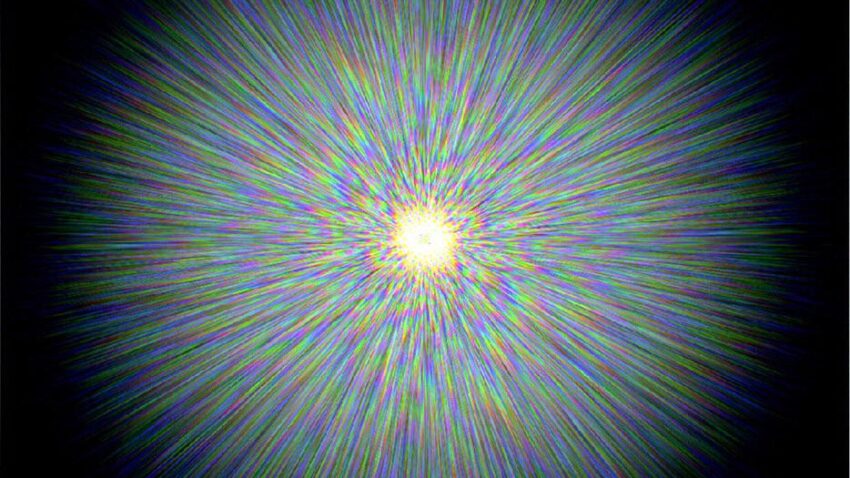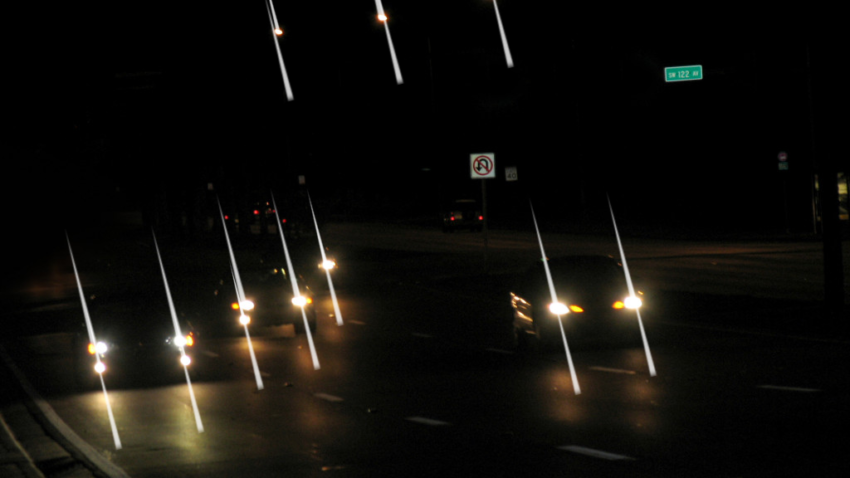The story of my left eye – so far: Part VIII
[NOTE: [Part I can be found here.
Part II can be found here.
Part III can be found here.
Part IV can be found here.
Part V can be found here.
Part VI can be found here.
Part VII can be found here.]
I meant to include these pictures in my series of cataract surgery posts and forgot.
The first photo is a pretty close simulation of what I saw with my left eye at night around streetlights and car headlights prior to surgery. It’s also what I still see with each eye, although it’s considerably smaller now in my left eye than it was before the surgery.
“Halo” doesn’t begin to describe it, although that’s the usual term. This photo is the best approximation I’ve ever found of the gorgeous geometric pattern of little rainbow diamond shapes – thousands of them – that I see and saw. The phenomenon in my left eye prior to surgery was large and surrounded the lights about six feet out in all directions, and was far more precise, complex, and beautiful even than this photo. If I were a better artist I’d try to draw it, but even then I probably wouldn’t succeed. Now, as I said, it’s smaller in my left eye, and it’s of intermediate size in my right. If it weren’t so disruptive to night driving it would simply be amazingly and awesomely beautiful:
And the rays in this second picture are what I now see in my left eye around lights at night as a result of my surgery. They were not present before. I created this image at a site (see this; and by the way I had all the phenomena shown there except “trails”) that gives you tools to construct so-called “positive dysphotopsias” (see this article if you’re interested in learning more about the dysphotopsia phenomenon). This photo is very close to what I actually see around lights when I drive in the dark, combined with the rainbow halos. It’s still much better than my vision was at night before the surgery. The lights overwhelmed just about everything else back then, and of course the rest was blurry and lacked contrast. This is considerably easier to process out and focus on what I need to see instead:
I’ve been told if I want to have the right eye done, I might get more of these dysphotopsias in the right eye afterwards, but a silicon lens rather than an acrylic lens would probably be less likely to cause them. However, a silicon lens is a more old-fashioned type that can lead to other problems.
Right now I’m taking a break from the whole thing and enjoying the improvements, which are considerable. Scenery is sharp and beautiful, street signs are legible, it’s much easier to use my computer, and those signs in the supermarket that designate what’s in each aisle are quite readable. It remains amazing.



That second image is at least more manageable. With the first, six feet around each headlight, I’m not sure I’d ever drive at night — or maybe even walk.
As one who has had vision problems I am so happy for you.
Kate:
I had completely stopped driving at night except a couple of blocks in my neighborhood.
I still don’t do a whole lol of night driving.
Guess you need to find out if better is good enough.
Thanks for this telling, hoping your luck stays with you on this
Until I saw the photos today, I didn’t think my eye problem was similar to yours. A few years ago, in my early 70s, I was diagnosed with Age-related Macular Degeneration and Fuchs Dystrophy. Night driving is frustrating and dangerous, so I avoid it. Other than that, my vision is okay, but I need readers for up close; I even passed the driving exam without my glasses. I had cataract surgery on one eye, which did not help at all. The doctors recommended AREDS2 supplement and Muro 128 eye ointment four times a day, but said that is only defensive. If I learn of a real remedy, I will let you know for sure.
Glad your eye problem is doing so well, Neo.
I recently had my eyelids done. The idea was to get more light into my eyes. And it worked. I can see more clearly and now read newspapers without using a flashlight to illuminate the print.
The recovery was a pain – ice packs on the eyes for 20 minutes of every waking hour for three days, applying salve twice a day, and sleeping in an upright position for seven days. (I’m a side sleeper, my sleep suffered for that week.) The stitches came out after ten days and the surgeon said I had healed better than average for a person my age. 🙂
I just had my shots for my wet macular degeneration. My vision has improved in both eyes. I’m happy I did it. I will be able to drive during the daytime and continue to read most printed material for a few years more. Simple pleasures.
A few years ago I had cataract surgery on my right eye. It had been severely astigmatic all my life, but the ophthalmologist installed the most extreme lens available. The result was a miracle: I can see! Due to some family issues and the pandemic I had to wait until now to get the left eye done, which happens a week from Monday. Wish me luck.
It’s up to physicsguy or me (also a physicist) to point out that it wouldn’t be a “silicon” (Si) lens, because Si isn’t transparent at visible wavelengths.
It would presumably be a silica (SiO2) lens. Fused silica is used in lots of technical optics for visible wavelengths … as well as optical fibers.
Silicone.
Not silicon, a metal, nor silica, a mineral with many types. But silicone, a polymer, which can be a liquid, a gel, or a solid.
Spelling is important.
But on a lighter note. Neo, thanks for the update, and to jj and others, I am gladdened to hear positive news about your vision.
Here is a link about Inter Occular Lens implants: acrylic and silicone.
https://www.aao.org/eye-health/diseases/cataracts-iol-implants
Silica (SiO2) has some significant biocompatability issues IIRC. Dose makes the poision.
I know a few things, and some of them are true. 🙂
Neo- thanks!! Not only will I be having eye-surgery for cataracts on the coming year or so, and find your multi-part posts fascinating, but also I have copied them and printed it out for some people I know who don’t have computers. One of them cried out loud because they had been so afraid!!
Thank you for all your efforts in this!
Yes, should be spelled silicone with an e.
Minta Marie Morze:
Glad to be of help!
So glad this has turned out so well for you. Thank you for sharing the journey.